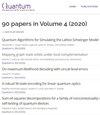酉通道下张量积结构几何
IF 5.1
2区 物理与天体物理
Q1 PHYSICS, MULTIDISCIPLINARY
引用次数: 0
摘要
在量子多体系统中,复杂动力学使物理自由度离域。这种信息在整个系统中的传播已经被广泛地研究与量子热化、乱置和混沌有关的问题。局部性通常是根据张量积结构(TPS)来定义的,TPS可以识别量子系统的局部子系统。本文研究了一种简单的算子传播的几何度量方法,通过量化局部算子空间与自身在酉信道下演化的距离。我们证明了这种TPS距离与局部子系统之间动力学的置乱特性有关,并且与对称双分轨情况下动力学的纠缠功率相吻合。此外,我们还提供了TPS距离最大化的充分条件,并证明了2-酉类提供了实现这一最大值的动力学例子。对于短时间的哈密顿演化,TPS距离的特征时间尺度取决于局部子系统之间相互作用强度决定的置乱率。在这个短时间范围之外,TPS距离的行为通过典型模型的数值模拟来探索,这些模型具有不同的遍历特性,从量子混沌和可积性到希尔伯特空间碎片化和局域化。本文章由计算机程序翻译,如有差异,请以英文原文为准。
Tensor Product Structure Geometry under Unitary Channels
In quantum many-body systems, complex dynamics delocalize the physical degrees of freedom. This spreading of information throughout the system has been extensively studied in relation to quantum thermalization, scrambling, and chaos. Locality is typically defined with respect to a tensor product structure (TPS) which identifies the local subsystems of the quantum system. In this paper, we investigate a simple geometric measure of operator spreading by quantifying the distance of the space of local operators from itself evolved under a unitary channel. We show that this TPS distance is related to the scrambling properties of the dynamics between the local subsystems and coincides with the entangling power of the dynamics in the case of a symmetric bipartition. Additionally, we provide sufficient conditions for the maximization of the TPS distance and show that the class of 2-unitaries provides examples of dynamics that achieve this maximal value. For Hamiltonian evolutions at short times, the characteristic timescale of the TPS distance depends on scrambling rates determined by the strength of interactions between the local subsystems. Beyond this short-time regime, the behavior of the TPS distance is explored through numerical simulations of prototypical models exhibiting distinct ergodic properties, ranging from quantum chaos and integrability to Hilbert space fragmentation and localization.
求助全文
通过发布文献求助,成功后即可免费获取论文全文。
去求助
来源期刊

Quantum
Physics and Astronomy-Physics and Astronomy (miscellaneous)
CiteScore
9.20
自引率
10.90%
发文量
241
审稿时长
16 weeks
期刊介绍:
Quantum is an open-access peer-reviewed journal for quantum science and related fields. Quantum is non-profit and community-run: an effort by researchers and for researchers to make science more open and publishing more transparent and efficient.
 求助内容:
求助内容: 应助结果提醒方式:
应助结果提醒方式:


